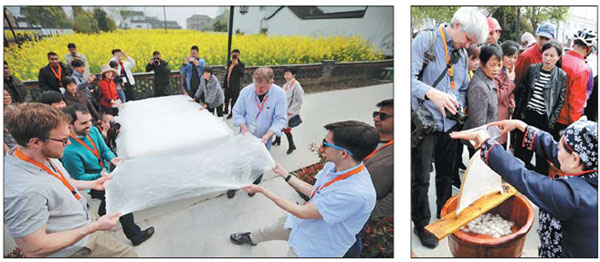Tongxiang's humble silkworm a symbol of China's culture, trade
In spring, Zhejiang province's 'capital of silk' goes all out to celebrate production, history of elegant fabric.
China is justifiably famous for its animal kingdom: The pandas of Sichuan province are incredibly cute, the elephants of Yunnan province are certainly majestic, and the Amur leopards of Jilin province are exceedingly rare.
When measured by their overall contribution to China's cultural heritage, however, one could argue that none of these famous animals can compare to a much smaller creature. For more than 2,000 years, it's been the humble, tiny silkworm whose cocoons have been transformed into the elegant fabric synonymous with luxury - and with Chinese trade.

Left: Foreign visitors learn about making silk quilts in Tongxiang, a city known as China's "capital of silk". Provided to China Daily; right: A local resident demonstrates silk making processes in Tongxiang. Li Jin / China Daily
There's no better place to witness this miraculous creature at work than Tongxiang, a beautiful city along the Beijing-Hangzhou Grand Canal in Zhejiang province. Though it's less than an hour's ride on the high-speed train from downtown Shanghai, Tongxiang is a world apart, with areas preserved or recreated to resemble the traditional Chinese water town of legend, and for that reason, it's become a popular destination with tourists, both domestic and foreign.
No one knows the exact location where the wonderful properties of this fabric were first discovered, but Tongxiang has been known as China's "capital of silk" since ancient times, and the city is still home to numerous villagers turning out the fabric in the old-fashioned way - weaving straw frames for the caterpillars to nest, harvesting the filament-like cocoons, then boiling the cocoons to soften the fibers, taking care to save enough silkworms to produce the next generation. Several of those fibers are then wound together, forming a single thread of silk.
The time consuming nature of such a harvesting process means silk is still rare - which accounts for its continuing value. But that's not the fault of the silkworms, just one of which can produce 1,000 meters worth of silk in their brief lifetimes.
Those threads go into an incredible variety of products, and as our scientific understanding grows, so do the ways this miraculous material can be used - in everything from upholstery to parachutes to surgical sutures. But of course, the most famous use of silk continues to be in luxurious blankets and fine clothing, and the especially lucky tourist may actually get to help stretch out the impossibly thin layer of silk that goes into making blankets, while wearing the sort of colorful, traditional Chinese garments that once graced the shoulders of emperors and other members of the royal families.
The silk, of course, has become synonymous with Chinese culture and industry, so valuable that it led to the establishment of ancient trade routes across the deserts of Asia, the inspiration for today's Belt and Road Initiative.
Arguably, the best time to visit Tongxiang is during the Tomb Sweeping Day holiday, when the city goes all out to pay homage to the hard-working silkworm. The Silkworm Worship Festival, or Ga Can Hua, attracts thousands of people from throughout China to the usually quiet village, as residents stage a traditional parade complete with dragon dances, children in colorful, traditional costumes and acrobats on stilts.
While presumably, no one still worships the ancient silkworm goddess Leizu, and cattle are no longer sacrificed to ensure a successful "crop", the festival is as colorful as ever, as the people of the city dress head to toe in yellow and red, honoring the diminutive insect that has made their city prosperous for two millennia. After all, doesn't such a hard-working animal deserve to be honored with a festival of its own?

